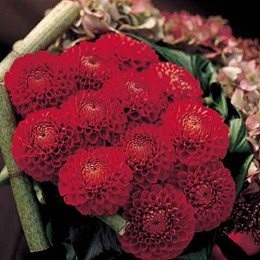
info about the flowers & plants association |
| the latest events in the flower world |
view the latest flower fashion trends |
green & gorgeous – boost your wellbeing with houseplants |
advice on where to buy & recommended retailers |
data & details about the flower industry |
how
to join and what benefits we can offer you as a member |
for
journalists & the media – what we can do for you |
index
of pages on this site to aid your navigation |
|
Dahlia
Name: Pronounced DAY-lee-a
Description: The native forms are quite simple and daisy-like, but breeding has resulted in some wonderful flower forms, including complete globes full of petals (pompoms), spiky and spidery forms (cactuses), and ones with curled tubes of petals like sea anemones. Origin: Dahlias are native to Mexico and South America, and have the vibrant intense colours associated with that part of the world. Availability: Main season June - October. Varieties: Dahlias and chrysanthemums with many-petalled flowers are closely related and often hard to tell apart. Dahlias have hollow stems, with raised joints where the leaves attach. Their leaves are smooth, usually with points, whereas chrysanthemum leaves are soft, with rounded edges. Care Tips: Dahlias are thirsty flowers, so check water levels regularly and remove leaves to reduce transpiration. Trivia: Facts: The National Collection of dahlias is held at Varfell Farm, Long Rock, Penzance, Cornwall. For a few days each September the collection is open to the public, when over 10,000 dahlias can be seen in full flower, against the stunning backdrop of St. Michael's Mount. For more information please visit their website at www.wgltd.co.uk History: Dahlias were first recorded by Westerners in 1615, when they were called by their Mexican name, acoctli. They disappeared from record until 1787 when a botanical expedition 'rediscovered' them, and sent seeds back to their headquarters in Europe. Their existence was kept secret for another ten years however.
| |
 |